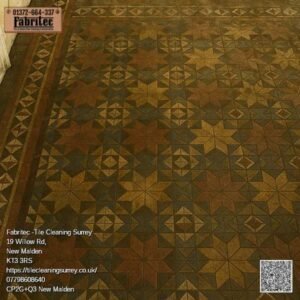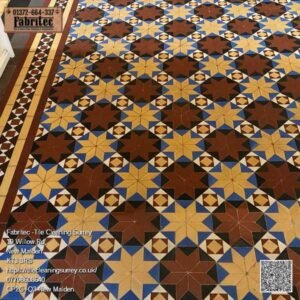Explore How Neglecting Victorian Tiles Can Diminish Your Home's Visual Appeal

Allow me to share an insightful narrative about a Victorian hallway located in Chertsey, which effectively illustrates the significant consequences of inadequate maintenance. Once, these tiles radiated a brilliant shine, exuding a captivating charm that welcomed everyone. However, with the passage of time, they succumbed to neglect following a hasty wax treatment. The once vibrant surface gradually transformed into a dull, lifeless expanse. The wax layer became scratched and discoloured, resulting in a disheartening, worn appearance that severely compromised the hallway's impressive character.
Upon conducting a thorough assessment of the hallway, I was relieved to discover that the tiles remained in relatively good condition overall—no replacements were needed, thankfully! However, a considerable challenge lay ahead. I recommended undertaking the labour-intensive task of removing the stubborn wax layer, followed by a comprehensive deep cleaning of the floor, and ultimately applying a modern sealer that would allow the tiles to breathe properly. After preparing a detailed quote for my client, they enthusiastically accepted my proposal, and we scheduled a date to commence the essential work. Let’s take a closer look at the meticulous cleaning process we undertook together!
Your Detailed Roadmap to Effectively Clean a Victorian Tiled Hallway
Here’s a systematic breakdown of how I approached this project. I divided the work into manageable sections, which significantly simplified the entire process. Initially, I applied a concentrated blend of tile cleaner and wax remover directly onto the tiles, diluting it with water to prevent rapid drying. This specific product is a highly effective cleaner designed to tackle stubborn wax build-up. Using hand tools, I meticulously scraped away the wax, and believe me, it was quite a messy endeavour!
The waste generated was predominantly a brown sludge—an attractive sight, wouldn’t you agree? I employed a scrubbing brush to remove the majority of it and then reapplied the cleaner, this time incorporating a bit more water for optimal results. Allowing the solution to soak for approximately ten minutes proved crucial in effectively breaking down any remaining wax residue, setting the stage for a thorough and effective clean.
Following this, I utilised a powerful tool: a scrubbing brush attached to a rotary machine. This remarkable device worked wonders, scrubbing away any lingering wax remnants with efficiency. Subsequently, I brought in a wet vacuum to effectively suck up all the sludge, making the cleaning process reminiscent of tidying up after a particularly messy toddler—less glitter, more grime!
Recognising the Importance of Moisture Management for Victorian Flooring
Now, here’s a vital consideration to keep in mind: traditional Victorian floors lack a damp-proof membrane. This absence means that moisture can rise from the underlying ground, leading to potentially detrimental consequences. Trapping moisture beneath the tiles can lead to rising damp and an array of other unwelcome issues, making effective moisture management essential for the longevity and overall health of the flooring.
After successfully removing the wax, I found myself somewhat concerned about potential moisture accumulation beneath the floor. If moisture rises, it can carry salts with it, leading to a condition known as efflorescence, which can tarnish the beauty of those exquisite tiles, leaving them streaky and stained. To mitigate this risk, I rinsed the floor thoroughly with fresh water and applied a gentle acid wash. This specialised formula not only cleans the tiles effectively but also neutralises any salts present. After another rinse to ensure no residues remained, I dried the floor as much as possible and allowed it to dry overnight.
Applying a Sealer: Ensuring Lasting Protection for Your Victorian Tiles
The following day, I returned to assess the tiles using a moisture meter—this step is critically important! It's essential to ensure that the tiles are adequately dry before applying any sealer, as applying a sealer to damp tiles can result in a patchy finish, which is certainly not the desired outcome!
I proceeded to apply four coats of a colour-enhancing impregnating sealer, ensuring a drying time of thirty minutes between each application. This sealer is water-based, which meant there were no unpleasant odours during the drying process. It works exceptionally well on Victorian tiles and provides a lovely, subtle silky finish that enhances their natural beauty and charm.
Once I completed the application of the sealer and took a moment to step back, the transformation was nothing short of remarkable! Shortly thereafter, my client texted me to express their delight: “Thank you so much for the lovely job. I never believed my floor could look so nice.”

Essential Aftercare Tips to Maintain the Beauty of Victorian Tiles
If you’re fortunate enough to have Victorian tiles in your home, I cannot emphasise enough the importance of using a pH neutral cleaner such as LTP Floorshine or Fila Neutral Cleaner to preserve their pristine condition. These cleaners are both gentle and effective—and being pH neutral means they won’t compromise the integrity of the sealer, which is crucial compared to conventional floor cleaners. Trust me, you really don’t want to jeopardise all that hard work!
Celebrating the Successful Restoration of Your Victorian Hallway
So, there you have it! Restoring this Victorian hallway was no simple task, but the end result was undeniably worth the effort invested. These historic floors possess immense character, and it’s incredibly rewarding to breathe new life into them. After all, who wouldn’t relish the experience of walking into a beautifully restored hallway every single day?
If you require professional assistance, don’t hesitate to contact Fabritec Tile Cleaning at 01337-664-337, or visit our website at https://tilecleaningsurrey.co.uk.
The post Uncover the Shocking Transformation of a Neglected Victorian Hallway In Chertsey! appeared first on https://tilecleaningsurrey.co.uk.
The Article Transformation of a Neglected Victorian Hallway in Chertsey appeared first on https://fabritec.org
The Article Victorian Hallway Transformation in Chertsey Was Found On https://limitsofstrategy.com

